
Stuart Page: performing on top of the Art Centre, Christchurch, 1981; with an Aaton 16mm camera, 1997; a selfie on K Road.
Stuart Page shares memories of special moments, close collaborators, photos, posters, and making music.
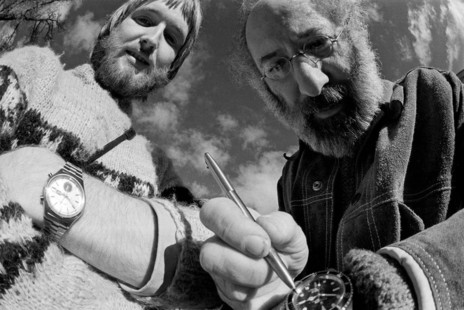
Stuart Page and photography lecturer Larence Shustak, Ilam School of Fine Arts, 1977. - Glenn Jowitt
I did a big exhibition of Shustak’s work in the Christchurch Art Gallery not long ago, apparently it was the most popular of the year down there. It was called air gun? – in lower case and italics. I thought the gallery would freak out. He’d walk around saying “air gun?” … no one knew what he meant. Shustak said, “When I arrived in Christchurch, everyone said this to me.” The gallery went with it. It was a big exhibition of his work, of New York and Christchurch stuff. That photo was taken by Glenn Jowitt in my second year at art school. I’d intended going into painting, but once I met Shustak I switched to photography. He was a hot line to everything interesting in the world. He had amazing books, subscribed to so many magazines, and had tons of media coming in. That’s what we wanted. He was a breath of fresh air. We had an open invitiation to visit him at his house. He’s one reason I got into playing music, I’d go around there and end up on the drum set, and he’d jam away on a banjo through a flanger. We’d be playing this psychedelic blues. A very cool guy.

Stuart Page as an art student, at 28 Garden Road, Christchurch, 1977. From left: Allyson Helm, Glenn Jowitt, Jenni Chrisstoffels, Stuart Page. - Stuart Page
Glenn Jowitt was the darkroom technician at art school while he was a student. I had a problem one day, when developing a film, it hadn’t cleared – there was something wrong with the fixer. I saw Shustak and asked what’s going on here? He shouted out “Jowitt!!” I felt terrible, he got stripped down by Shustak for mixing the wrong dilution. Glenn looked at me, “Who the fuck are you?” We became friends.
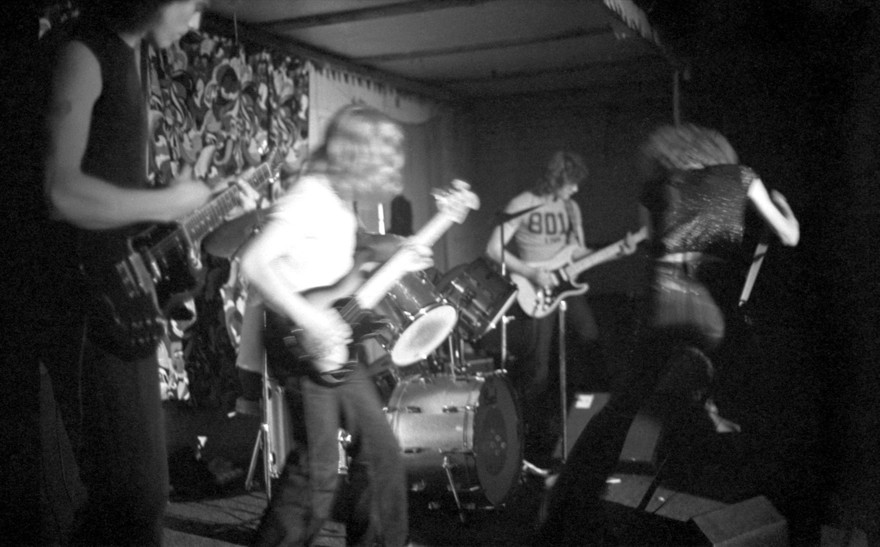
The Doomed, fronted by Dick Driver, at Mollett Street, Christchurch, 25 July 1978. - Stuart Page
I don’t know how I ended up at Mollett Street, I hadn’t really got involved in the music scene at that point. Someone must have just suggested it, and off we went. I was living at 43 Knowles St – a lot of musicians lived there over the years, it was a big mansion, well known. A wonderful house with enormous rooms; Glenn and his girlfriend were living in the servants’ quarters. I was into music, but just records.
I started photographing music a lot in 1978, and I went to the manager of the Christchurch Town Hall and said I’d like to photograph the touring groups. He gave me a pass that gave me carte blanche entry for the whole year: backstage, everywhere. Stéphane Grappelli, Lou Reed, Joe Cocker, The Inkspots, Chuck Berry (I went to find the negatives when he died, but couldn’t – a piss-off).

Michael Shannon and Stuart Page at their Springbok Tour protest photo-screen print exhibition, Bowen Galleries, Wellington, 1981. - Stuart Page Collection
I was running a printery at the University of Canterbury Student’s Association, called A4 Art. I’d seen this guy around, Michael Shannon. He was studying law, and he turned up one day and said, “Why don’t we do some screen prints of these images?” I’d been taking photos on protest marches, and he’d started collecting pictures out of the paper. We decided to screen print these photos and made these books. And the Student Union generously gave us a big room to set up a screen-printing studio. We made all the prints, had books bound, and then had an exhibition in one of their lounges. I think we sold all the books at the opening, and then printed another edition of 100 books. At the Wellington exhibition, we set up a projector outside the Alexander Turnbull Library [on Bowen Street], and projected images of police and protesters onto the walls of the Beehive. All these police cars lined up and watched it. Then one of them told us we were trespassing. We packed up quickly. A newspaper clipping was headlined “Beehive Bok Bright By Night”. At that opening I first met Roger Riot – later Fogorelli – with Void, they were Riot 111. I remember Void shimmying up this lamppost and he put his coat over the light so it didn’t shine on the projection. The things you could get away with then. It wasn’t graffiti, it was just light. They couldn’t get us for defacing the Beehive.
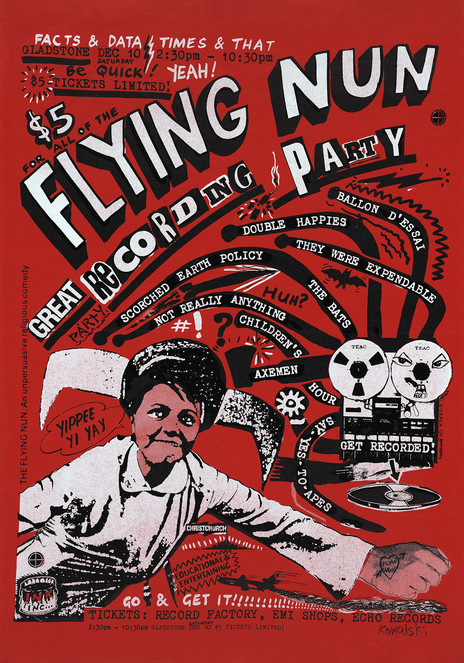
Flying Nun Great Recording Party; a screen-printed poster designed and printed by Stuart Page, November, 1983.
Maybe Hamish Kilgour asked me to do it, at the end of 83. AXEMEN had just started in September, and somehow we got wrangled into this event. I got the names of the bands, got a picture of an 8-track – it belonged to The Gordons – and collaged it together. A combination of found text, hand-written text, found images. We got the recording of our set mixed by Terry King. We posted him a half-size bottle of whiskey and asked him to mix the AXEMEN tracks, which he did, and we put one song, ‘Yeasty Mayor’, on our first album Three Virgins. No one seems to know what happened to the rest of those tapes, one of the great mysteries. That’s a lot of big tapes.
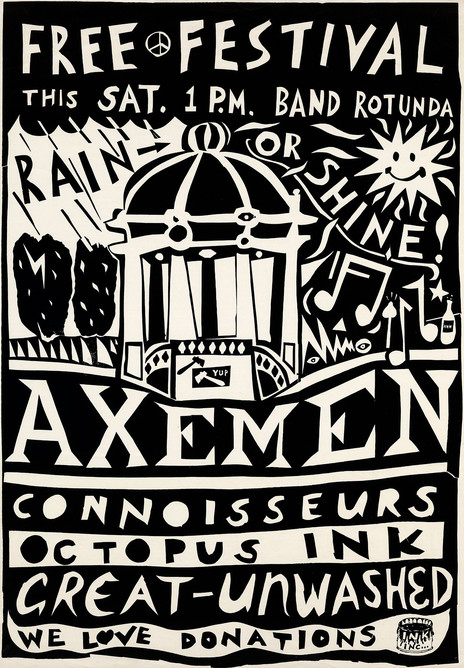
Free Festival: AXEMEN, Connoisseurs, Octopus Ink, The Great Unwashed; screen-printed poster designed and printed by Stuart Page, 1984.
There was this product called Rubylith: a two-layered plastic sheet like a heavy clear polyester backing sheet. And on top of it is a softer, red film. I had a little swivel knife for hand cutting, and I’d do a design on paper, and then go to a light table, put the film over top, and then cut the film and peel it away. So that’s how that was made.
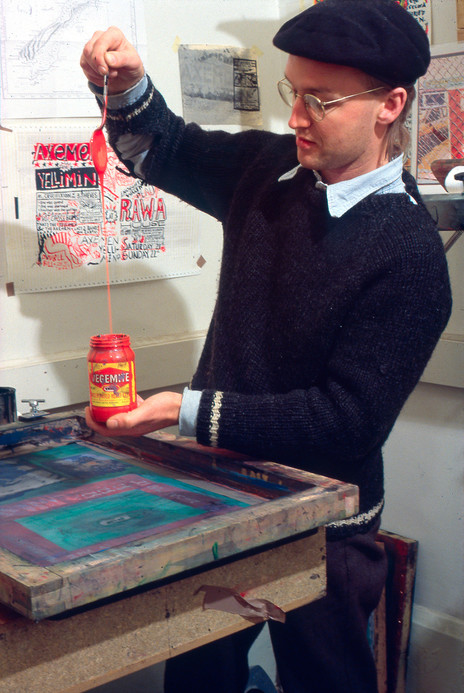
Stuart Page at his Ink Inc screen print studio, 2/222 High Street, Christchurch, 1985. - Stuart Page Collection
I was studying photography at Ilam and saw an honours student Hamish Thompson screen printing his beautiful graphic design poems, and I was blown away, with the tiny letters and amazing details. I had screen printed as a kid, but hadn’t realised you could get such quality and detail. So I did a 180 from the black and white 35mm documentary-style shooting I’d been doing. I’d been photographing commercial “artefacts” – gimmicky advertising stuff, signs, mannequins, I hadn’t taken them seriously, but [Ilam photography lecturer] Shustak said “These are cool, what are these about?” Just for fun, I said. “They’re great.” I had this idea of screen printing these advertising images in colour. I worked out how to do it, and made a book of them called Artifacts – maybe 40 images – and I submitted that in my final year, 1979, as my honours presentation. I was screen printing up until the 90s, and always had a studio, it’s been a very cool thing to be able to do. Once I started playing music – drums from 1983 in various bands – it became very useful for making posters, LP jackets with cassettes inside, T-shirts, I used to make money selling T-shirts of my favourite bands to the Echo Records shop in Christchurch. The most famous sale was when Paul Simon bought about four T-shirts for his son. An Elvis one, The Fall, Pere Ubu ...
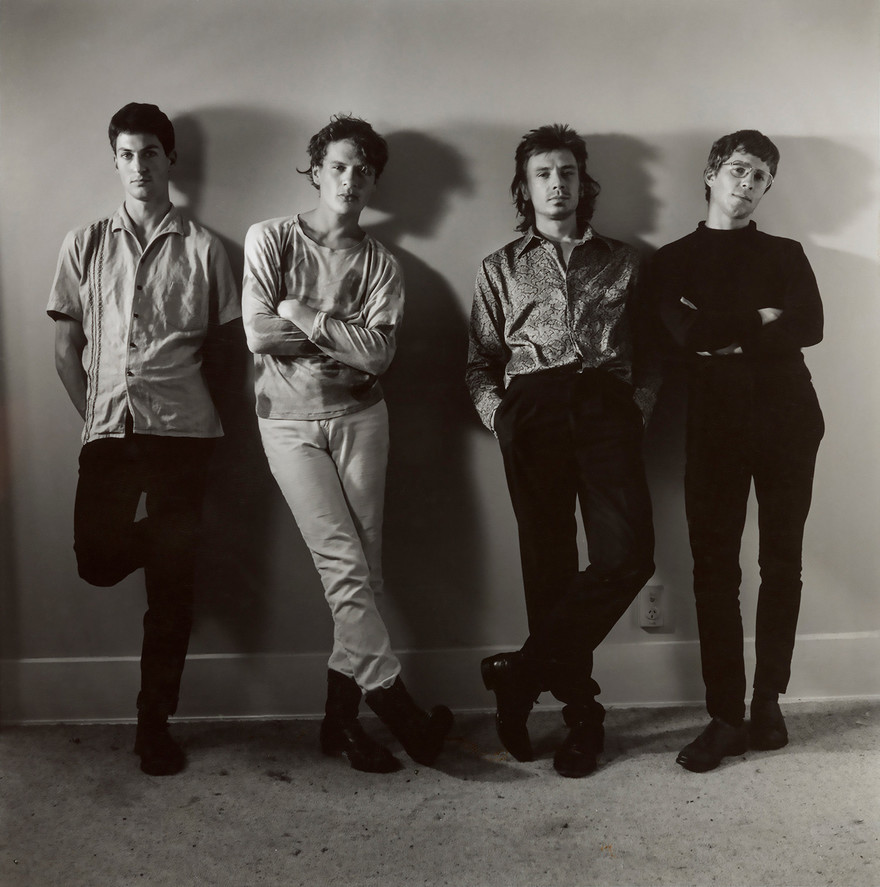
Straitjacket Fits, photographed by Stuart Page at Shayne Carter's Browning Street flat in Grey Lynn, 1988. Left to right: John Collie, Shayne Carter, David Wood, Andrew Brough.
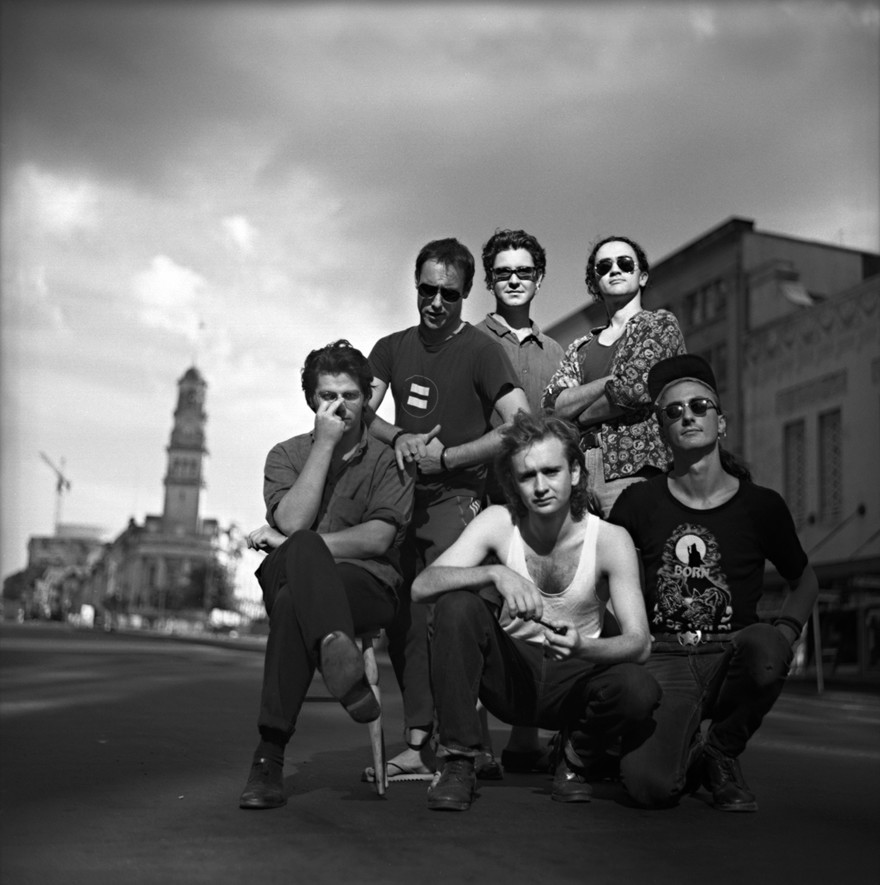
Headless Chickens, photographed by Stuart Page on Queen Street, Auckland, 1988.
Anyone who owned a wind-up 16mm Bolex camera, you met them eventually because you’d borrow lenses from each other. That’s how I met Grant Fell. It was quite a tight little group, including me, Chris Knox, Grant, Brett Orams, Greg Wood, Norbert Haley – they’re the people I can remember with windup 16mm Bolex cameras. Grant and I made music videos together, the Headless Chickens’ ‘Donka’ was the main one. They were planning to tour Australia, and Grant and I made an ad for Flying Nun: In Love With These Times, the only Flying Nun TV commercial. We got paid, and that paid my ticket to Aussie. I’d started projecting slides and 16mm film over them while they were performing, and they wanted me to do that. This was one of the photos I took for publicity for that trip. This one was never used. I loved the intersection of Queen and Wellesley [Streets]: the sun would reflect down on to the street from the mirrored buildings. We had to wait for the pedestrian crossing light to go green, we’d run out, only have a minute, take a few frames, then run off again. We did a series of photos that way.

Inhabitants of the Red House, 8 West Tce, Auckland, 1990 - Stuart Page, Auckland Libraries Heritage Collections 273-PAG068-02
I wanted to reveal aspects of what I’d seen in Auckland that I thought might have easily been overlooked. So I focused on the working people in Auckland, and these guys were living – an underground lifestyle, you could call it. It was not your average flat, there was a high amount of creativity going on at all times. It was the headquarters for a lot of stuff going on round K Rd to do with music and anarchic creativity. The kingpins were Roger Fogorelli – seen here with his dog Zak – and the guy on the motorbike, Lindsay Fog. I connected with them on a couple of visits to Auckland and in the end, when I said I was thinking of moving up, they said you can come and live with us. I came up on a train from Christchurch, and I had about 17 tea-chests full of stuff, as baggage on the train. I rang up NZR and said how many items can you take? “How many you got?” About 20. “Should be okay.” Roger and Lindsay picked me up in the van. I lived there for a while, but moved out soon after. It wasn’t really for me. A great place to visit.
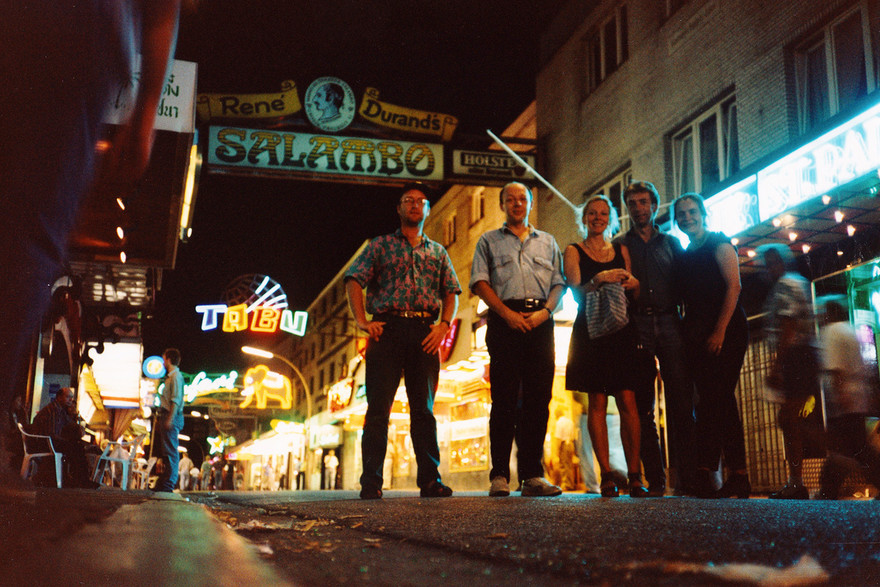
Stuart Page, Hollow Skai (punk historian), Saskia Ruth (sculptor), Thomas Hartlage (QDK Media), and Jutta Wübbe (comedian), at the site of The Star Club, Hamburg, July 1994. - Stuart Page
In 1986 Thomas Hartlage – a German filmmaker – came out to New Zealand, and I helped him meet the current Flying Nun bands. We travelled around the country – to Dunedin to meet Sneaky Feelings, The Verlaines, The Clean, The Chills – then moved our way up and met Able Tasmans in Auckland. Thomas was planning on doing a film which involved all of these bands playing in a festival set at the Powerstation, and each band had a visual artist assigned to them – Ronnie Van Hout, Lesley Maclean – people who’d done artwork for Flying Nun. And what would tie it all together was the AXEMEN. [The idea was] I’d gone missing, travelling on an Indian motorbike, after going to see my girlfriend, who was played by Rosanna Raymond – it was a bit cheesy – and that was going to be cut in between performances. I ended up doing all this pre-production work, engaged Stuart Dryburgh to be DOP, he had engaged five other camera operators, all in 16mm, and I moved up to Auckland some time in 1987. Then there was the stock market crash, the Bavarian financier lost all his money and the project fell over. It was going to be called Anything Can Happen. I still have the hand cut artwork for the poster, it’s never been printed.
That’s how I met Thomas. He had a film company, QDK Media, and they did a series of little TV movies based around this German comedian Jutta Wübbe, who’s in the photo. She’s a very popular comedian in Germany, with sell-out gigs. She’d travel around the world and stumble into situations, and they set one in New Zealand. Her character name was Frau Jaschke, so it’s Mit Frau Jaschke in Neuseeland – which is where I got the idea for the name Noisyland, now the name of my YouTube channel. They came out and shot this thing. I was involved in pre-production and still photography, location manager. They told me to collect their GST refund, and said, that’s yours. It was quite a lot of money. So I bought a ticket and went over and visited them. Thomas was in Hamburg, and we went out to the Reeperbahn and old Beatles haunts.

Stuart Page in a Phantom Billstickers' "Raymond Louis" logo T-shirt.
Raymond was Jim Wilson’s bulldog, it’s the company logo. That design came from a poster I did for the Bilders, taking off With the Beatles. On that record cover they had a Parlophone logo, and I used that to make a Phantom logo for our Bilders posters. They were blown away by the logo and asked if I could turn it into a logo for them. Where it says “Phantom” it said “Parlophone” on the other one. It stayed their logo for quite a while.
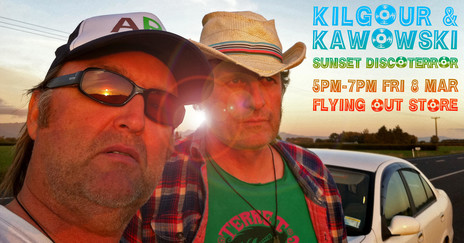
Stuart Page and Hamish Kilgour, publicity image for the 2015 Sunset Discoterror event. The photo was taken in Matamata on their way north after visiting Christchurch following the 22 February 2011 earthquake. - Stuart Page
Hamish [Kilgour] would often come back to New Zealand, and he turned up on the day of the Feb 22 earthquake. We had arranged to do a rehearsal: him, me and Danny [Mañetto, of Shaft and The Mad Scene]. I was heading out the door, and my flatmate yelled out “There’s been another earthquake!” There’d been a lot of aftershocks. I drove out to meet them and got a text from my mother, saying “I’m OK”. I thought, What’s that about? I went inside, Danny turned the TV on and we saw the Cathedral spire crash into the Square. Holy fuck! We tried to get hold of our mums, but the cell network was overloaded. We did the gig that night in Tabac [Auckland] and I remember we were organising people to look after our mothers. Hamish and I decided we’d fly down there, to check in on our friends and mothers. My brother went down and got my mother. We visited people, then Hamish got a rental and I drove us back up to Auckland. I started DJing at Golden Dawn, accidently, and I got Hamish to come along as a selector, and used that photo of us to publicise the event.

Stuart Page at Graceland, Memphis, 11 November 2009, on the AXEMEN 2009 USA tour. - Dragan Stojanovic
The AXEMEN took a hiatus in 1992 because Stevie McCabe was having some problems with drinking. But when I turned 50 in 2007, I decided to have a big party. I hadn’t been in touch with Steve for a long time, 15 years, and I tracked him down and invited him and Bob [Cardy/Brannigan], the other Axeman, to my party. So a lot of people saw the three of us together again. It didn’t take long – people thought we were playing again, so we got invited to play, around Auckland, and we toured to Wellington and Whanganui with The Hairdos. Then out of the blue a cool, young post-punk trio from Columbus, Ohio, called Times New Viking – it’s a design joke – got in touch and said “We’re doing this big US tour, do you want to come over and open for us?” Of course we did. We did 26 shows in five weeks, all around the States. We had a day off in Memphis, we went to Graceland, and the Stax museum.
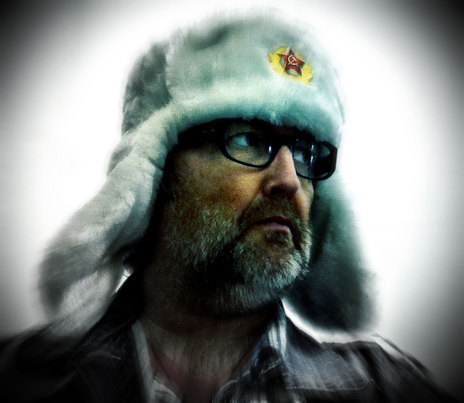
Stu Kawowski of the AXEMEN, 2012 - Stuart Page
A selfie: they used to call them self portraits in the old days. Jim Wilson had been over to St Petersburg in Russia and brought back a lot of those Russian hats. I think it’s me mucking round in PhotoShop. I’ve got a really good iPhone I use a lot, but I also use a Panasonic Lumix GH5 which shoots 4k movie footage and stills. I haven’t shot any film for a long time. I found the digital camera revolution really liberating, because you get the results immediately and you can take as many as you want, you don’t run out of film.

Stuart Page with US poet Gerald Stern, Lambertville, New Jersey, 8 March 2012. - Bridget Sutherland
Phantom Billstickers arranged a poetry event in New York City in 2012, at the Saatchi Building. They flew over about eight poets from New Zealand, and I went over with Bridget Sutherland. We’d done a few film projects together, and we documented the event. We hired some extra camera guys over there and filmed the event, but we also took the poets around various parts of New York. We filmed on location: at 9/11 ground zero, Central Park, the Guggenheim, various other locations. Gerald Stern had come into the city to read some poetry, and we decided to go and visit him in Lambertville, New Jersey. We were planning how to get there, and Bridget’s sister Jane handed me the card of an ex-KGB guy with a limousine who drove us down there. We met Gerald Stern, filmed him reading poetry in his house, and then he took us out to lunch.
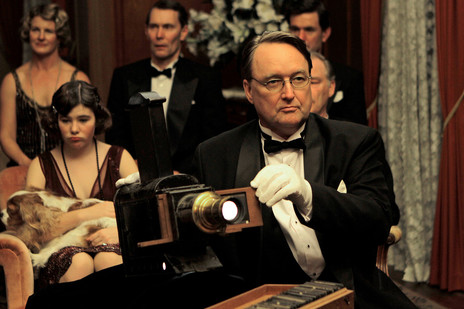
Stuart Page as Frank Worsley's projectionist in the 2012 TV movie Shackleton’s Captain. - Andy Salek
I got asked to take part in Leanne Pooley’s film about Frank Worsley, Shackleton’s captain. His photographer Frank Hurley took amazing photos, and they would tour around English aristocratic circles, giving lectures about the whole Antarctic adventure, projecting the glass slides. I was asked if I could make a digital slide show of Hurley’s photos, and have the pictures sliding off as if it was an old-fashioned projector. I did that, and they said, could you come and operate the DVD player and the projector. Sure! Then, “Would you mind being on set like a featured extra?” Okay then, off I went, got fitted in a tuxedo and had my hair cut. So I was operating the old-fashioned projector on camera, but I had the digital one underneath the table out of sight. [Shackleton’s Captain can be viewed at NZ On Screen.]

Stuart Page with Barry Jenkin at his home in Thames, while operating camera and sound for an interview by Mark Everton.
[TV director] Mark Everton has been a friend of Barry Jenkin for a long time, and he thought it was a good time to interview him. So we packed off down to Thames where he lived, and spent most of the day there. Barry is looking through his photo album. He still had a lot of his original vinyl collection, well worn, and well played: The Ramones, The Fall, really cool 80s post punk. Fantastic guy, really funny, irreverent. We were looked after well.
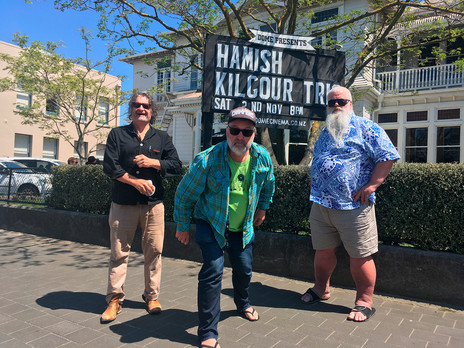
The Hamish Kilgour Trio outside the Dome Cinema in Gisborne, 4 November 2019. From left: Hamish Kilgour, Stuart Page, Daniel Mañetto. - Ed Gains
We did a little tour at the end of 2019, and that’s us outside the Dome Cinema, a wonderful place in Gisborne. The women who run it are fantastic, it’s a real pleasure to visit. It’s a venue, actually a cinema – in a beautiful heritage building – but they show films, do gigs as well as running a restaurant and bar.

Finished poster for the Hamish Kilgour Trio Spring Thing tour, 2019. Drawing by Hamish Kilgour, design and colourisation by Stuart Page.
It needs to be clarified that Hamish did the drawing – I did colourisation and design for poster. We went on two tours that year, 2019, and we were partly organising the tour while on the road. I filled in venue details for the poster designs while on tour, and emailed the artwork to Phantom Billstickers. Jim Wilson looked after us.
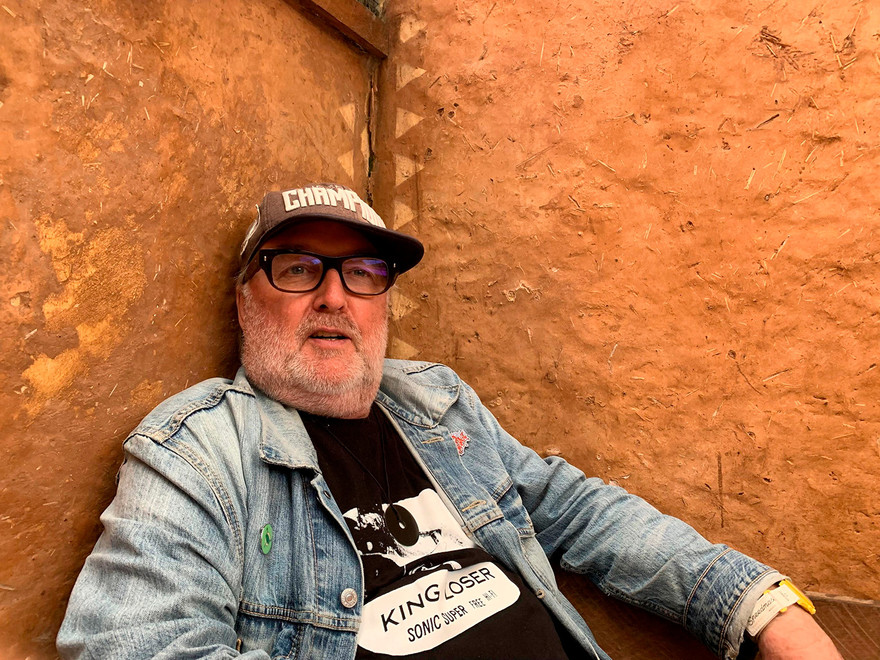
Stuart Page "chewing the phat in the last booth," Conch, New Year's Eve 2023. - Ray Castle
--
Read more: Stuart Page (multi media), part one